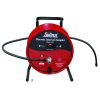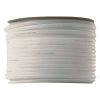Solinst Model 425 Discrete Interval Sampler
Features
- Avoids purging and disposal of purged water
- Obtain high quality discrete zone samples
- Profile wells or open bodies of water
- Free ground shipping
- Expedited repair and warranty service
- Lifetime technical support
- More
Overview
The Solinst Model 425 Discrete Interval Sampler is a stainless steel groundwater sampler designed for use with LDPE tubing mounted on a reel. The reel has a pressure attachment for a high-pressure hand pump and a pressure/vent switch, which is used to apply and release the pressure on the sampler. A sample release device is included with each standard Discrete Interval Sampler.
Applications
Discrete interval sampling is ideal for obtaining truly representative groundwater samples from below floating product layers, or for obtaining samples of the product itself. The discrete interval sampler can also be used to profile open bodies of water and boreholes, and to collect samples from distinct levels or points of inflow. The Discrete Interval Sampler is a passive sampler that is pressurized when lowered and upon retrieval to prevent water from mixing at different levels. Designed to give zero purge samples.
Models
Solinst also offers the Model 425-D Deep Sampling Discrete Interval Sampler for obtaining samples from submerged depths as much as 1200m (4000 ft). Biodegradable disposable PVC bailers and stainless steel Point Source Bailers are also available.
- (1) Model 425 Discrete Interval Sampler
- (1) Sample Release Device
In The News
Three Decades of Research at Acton Lake
A multi-disciplinary team at Miami University, Ohio, has been studying the environmental change at Acton Lake for over three decades. Using three different NexSens buoys over this time, the team has an incredible archive of data that is helping build a picture of Acton’s past, present, and future. Until recently, a NexSens CB-50 buoy was used alongside other environmental monitoring at Acton Lake. In May 2025, the Miami team deployed a new XB-200 buoy , future-proofing their ongoing monitoring using real-time buoy systems. Acton Lake, a small hypereutrophic reservoir in southwest Ohio, covers 2.4km² and has a maximum depth of about 8m. The dam was built in 1956, and the lake has a large agricultural watershed.
Read MoreSource Water Monitoring in Albany, New York: Tracing Water Quality throughout Tributaries
Thousands of US cities pull their drinking water from natural source waters like reservoirs, rivers, and streams, making overall watershed health a key consideration for water providers. In Albany, New York, the Albany Department of Water and Water Supply delivers drinking water to over 100,000 residents as well as monitors and manages the larger drinking water supply watershed. Hannah Doherty, Environmental Specialist at the Albany Department of Water and Water Supply , spends her days working with a small team to monitor the drinking supply and the connected water bodies. Doherty explains, “We’re the first to encounter the water that ends up being the drinking water.
Read MoreWildfire Prevention in the Sierra Nevada Region with the Yuba Watershed Institute
Though recent wildfires have sparked new conversations about wildfire management and response, groups like the Yuba Watershed Institute have been monitoring the forests and water resources of the Sierra Nevada region for decades, managing approximately 5,000 acres of land with the Bureau of Land Management (BLM) and about 7,000 acres in private land partnerships. The goal of the Institute is to work with local communities and land agencies to improve watershed and forestry management through informed practices and public outreach. The goals of the Yuba Watershed Institute are three-fold: Improve the ability of fire suppression agencies like the California Department of Forestry and Fire Protection ( CAL FIRE ) and the US Forest Service.
Read More






















